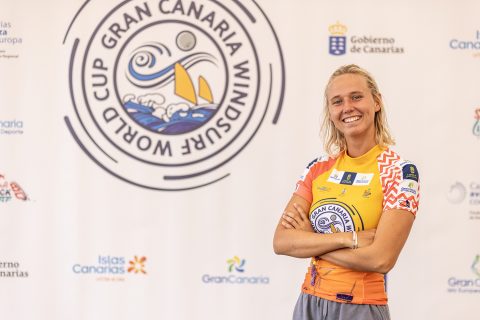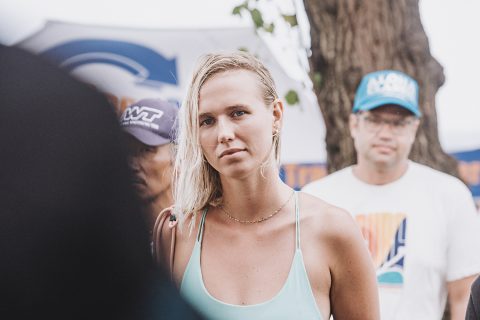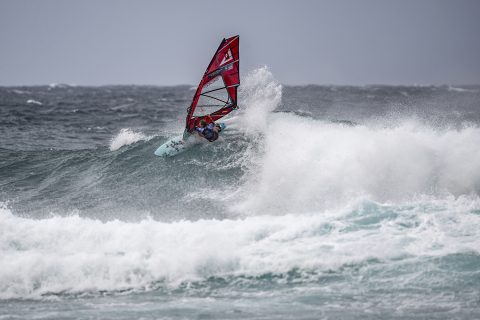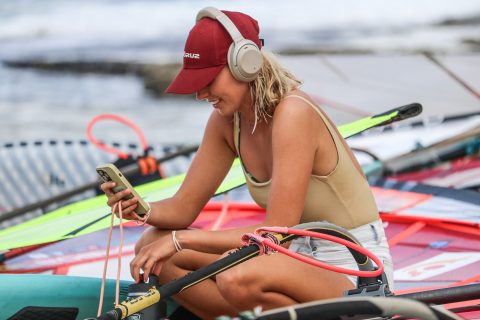COCO FOVEAU: DEALING WITH CONCUSSION
My Concussion: Two Years of an Invisible and Misunderstood Injury!
In 2023, a brutal crash during the PWA Gran Canaria competition left Coco Foveau with more than just a few bruises; it triggered a serious concussion that would go on to affect every aspect of her life. What followed was not just a physical recovery, but a deeply personal battle against an injury that’s often dismissed because it can’t be seen. Two years later, Coco is still navigating the long and winding road of post-concussion syndrome…and she’s ready to share her story.
As some of you already know, I’ve been battling an invisible injury for the past two years. Along the way, I’ve come to realize that I’m not alone…and that because this injury is invisible, society tends to dismiss or ignore it. So I’ve tried to put my experience into words. But first, let’s go back to where it all began.
REWIND
The year 2023 was both the best and worst year of my career. I finished the season ranked 3rd in the world, but I also suffered a fall that changed my life. The diagnosis: a mild traumatic brain injury; in other words, a concussion.
Technically, that means I may have suffered micro-lesions in my brain due to the impact. These lesions are invisible to standard medical imaging, but the symptoms speak for themselves: blackout, nausea, confusion right after the accident. I was taken to the ER, where I was handed a prescription for paracetamol in case of headaches and that was it.
- Coco July 2023
I quickly realized something was very wrong. The symptoms intensified over the following days: hypersensitivity to light and sound, huge headaches, extreme fatigue, dizziness, nausea, mood swings, anxiety, sadness, cognitive dysfunction (trouble concentrating, paying attention, remembering things)…
I was thrown into an ocean I didn’t know how to navigate…unable to predict the currents or keep my head above water.
I knocked on every door: ER visits when the pain was unbearable, general doctors, sports doctors, osteopaths, physiotherapists, radiologists, neurologists… While many showed compassion, I was often met with disbelief. Since nothing showed up on my scans, they told me it would pass. I just had to be patient. Eventually, they upgraded me to stronger painkillers. Tramadol became part of my daily life for a year.
You should know; I’ve always tended to trust what a doctor tells me. Maybe it’s because my late father was a GP who made it his mission to take care of his children. I struggle to separate the role of a doctor from that of a parent.
And with the debilitating fatigue from the fall, I just didn’t have the energy to challenge what I was told. So, I followed their advice, because that required the least resistance. And yes, when one of them eventually told me months later that it was “all in my head,” I even explored the psychological route.
I felt crazy for believing I could be doing this to myself…even though I loved my life before the accident, and it broke my heart to watch it slip away during this so-called recovery.
- COCO FOVEAU
That being said, I don’t want to suggest that no professional helped me. Many did what they could within their specialty. What I do criticize is the lack of humility and curiosity some showed. When a patient comes to you, you’re their point of reference. If you’re not confident in this area, I wish more doctors would simply say so and refer patients to someone who might have more answers. And if they don’t know who that might be, then at least offer some leads based on their general knowledge.
Because unfortunately, I had no idea how the healthcare system worked. I didn’t even know what kind of specialist I was supposed to look for.
The same thing goes for one’s social circle. A lack of humility of admitting you don’t know and a lack of curiosity to learn more can deeply affect someone who’s already suffering. I had so many conversations with people who couldn’t believe a “simple fall” could have such lasting consequences:
“It’s probably your subconscious.” “Maybe it’s the vaccine.” “Could be your birth control.”
So many rushed opinions and snap judgments based only on what they thought they knew.
But I get it; who doesn’t make the mistake of judging a book by its cover?
How could something called a “mild traumatic brain injury” cause such massive life disruption?
Maybe we need to rethink the terminology altogether.
- Coco ripping in Maui
I’ll speak from personal experience now…because here’s what I’ve taken away from this journey:
Modern medicine and society still largely operate under the idea that “if it’s not visible, it doesn’t exist.”
And yet, I had a body that no longer functioned the way it did before the accident. I couldn’t get through the day without help from those around me.
DAILY LIFE
To give you an idea; 1 year and 10 months after the accident, here’s what my daily life looked like:
I only had enough energy for a few things. I tried to find balance between my mental and physical health and my adult responsibilities. I worked maybe 1–2 hours per day, not even every day. I found small joys in slow activities like colouring or crochet. I listened to my body and took 2–3 naps a day. I no longer had a regular workout routine. Physical preparation was out of the question, and I could windsurf maybe 30 minutes a week if I was lucky. I didn’t drive anymore; if I used my energy to go somewhere, I wouldn’t have enough left to do the thing I went for.
And so on…
The truth is that this injury is anything but trivial. It has specific protocols in many ball sports (rugby, football, handball…).
And yet, as a high-level athlete listed by the French Ministry of Sports, I spent more than a year in medical limbo. Apparently, concussions don’t exist in French sailing.
But just because we practice what’s seen as a “beach sport” doesn’t mean the injuries can’t be serious.
And the same applies to everyday life; you don’t have to be an athlete to be affected.
I’ve heard stories from people who got concussions just from bumping into a pole while walking down the street, or closing their car trunk too fast…and they were left with the same debilitating symptoms I had.
This experience makes me worry for others.
With the status and support I had, it still took me nearly two years to be heard and taken seriously.
I’m still fighting with insurance, which considers my injury equivalent to a “stiff ankle.”
But what about the recreational athlete, the student, the young professional, the parent, or any average person? Will they get stuck in the same nightmare?
HINDSIGHT
In hindsight, I now realize this wasn’t my first concussion, the others were just ignored because they didn’t leave visible marks.
That’s why I want to raise awareness about this type of injury. It can happen in ordinary, seemingly minor ways and still have life-altering consequences.
- COCO FOVEAU
Today, I’m not fully recovered.
Maybe I never will be, given the delays and mismanagement of my care.
But I can finally say that I’ve found a specialist who truly listens and is giving me real results to help me heal as much as possible.
For those who want to better understand what I’ve been going through, I also recorded a video testimony on my YouTube channel, where I share the daily realities of living with a concussion.
A special thank you to Dr. Chermann, a neurologist specialized in sports-related concussions, who has dedicated his career to improving how this injury is understood and treated.





